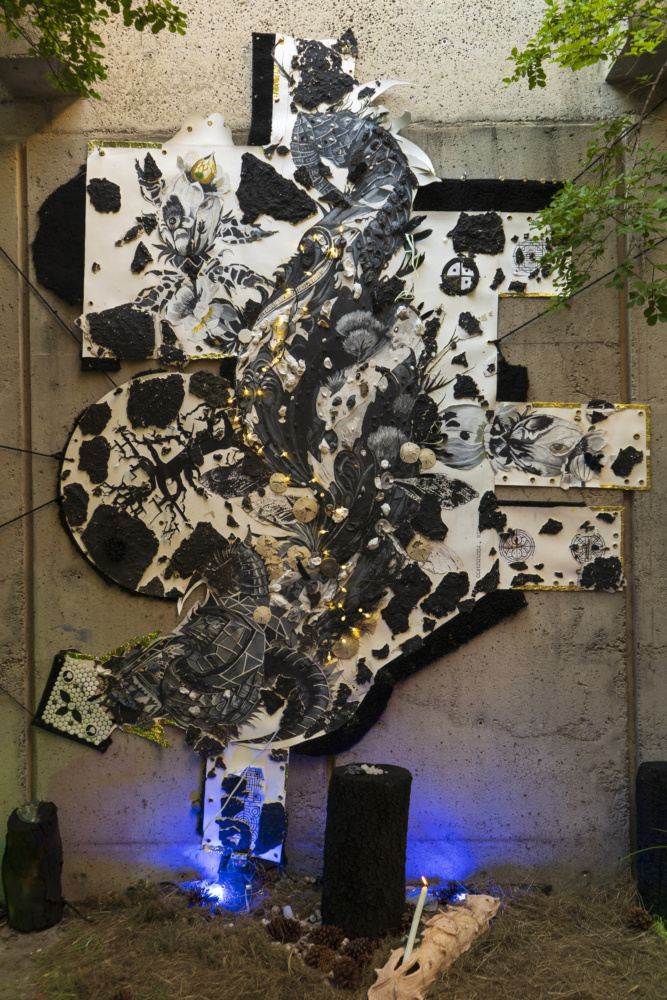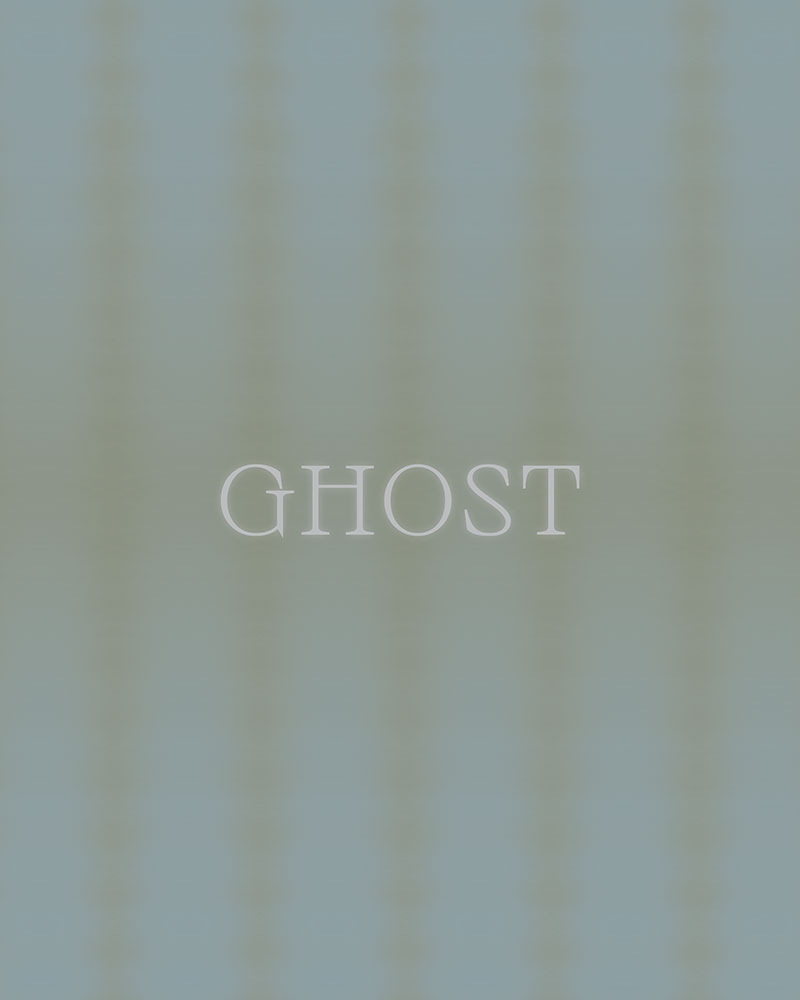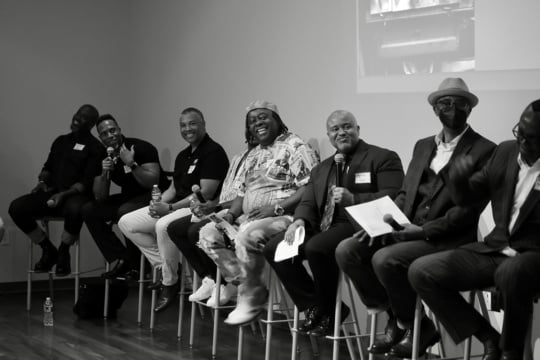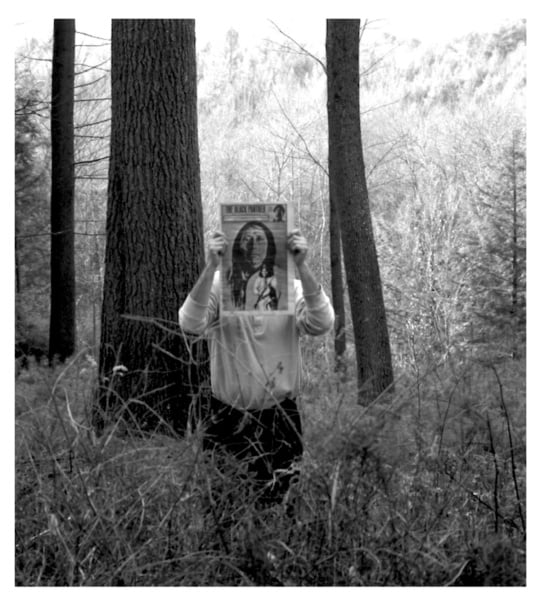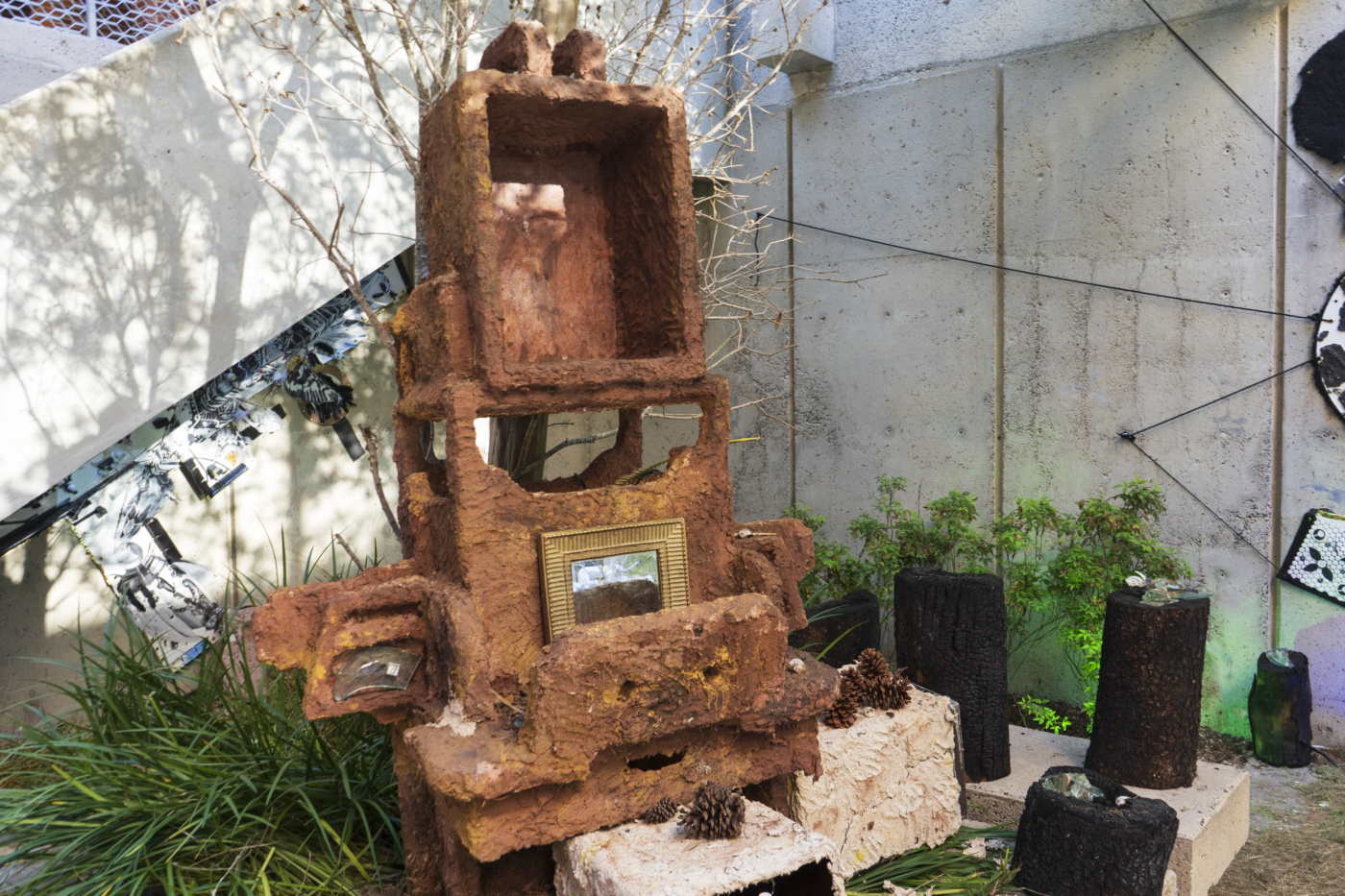
In the world of Tevin Lewis, nothing is wasted. Every discarded seed, scorched fossil, ghost fruit, memory fragment, becomes material—not inert substance to be shaped, but living matter, pulsing with history and myth. To encounter Lewis’s work is to step into a layered cosmology in motion: a generative system where Caribbean spiritualities, Black diasporic grief, ecologies of survival, and sustainable design converge.
Mystery Antenna Key (2025) offers a vivid entry point. The sculpture reads as shrine and transmitter, part ritual machine and part spiritual engine. Its cruciform frame is studded with mirrored spheres and crosshatched forms that recall circuit boards, veves—intricate ritual designs in Haitian Vodou that summon spirits into presence—and coded diagrams. Jagged shards pierce its surface like spectral echoes of the Larabanga Mosque in Ghana: architectures of memory and continuity.
Lewis’s practice spans sculpture, immersive installation, digital media, and speculative storytelling—modes through which he builds dynamic systems animated by chaos and order, ritual and technology, form and feeling. At their center is what Lewis calls the “Basse”: a physical and metaphysical engine, both real and imagined, where matter and myth converge. In the logic of the Basse, everything feeds everything else. Emotion becomes energy, energy becomes object, object becomes story, and story becomes environment. Foundational to the Basse are seeds—small amulets that carry latent potential. Keys emerge as manifestations that unlock parts of the narrative system that is the Basse; in turn, the Basse becomes a mutable framework that holds history and speculation. It is a site of becoming, where discarded matter transforms into portals, and the spiritual and technological coalesce.
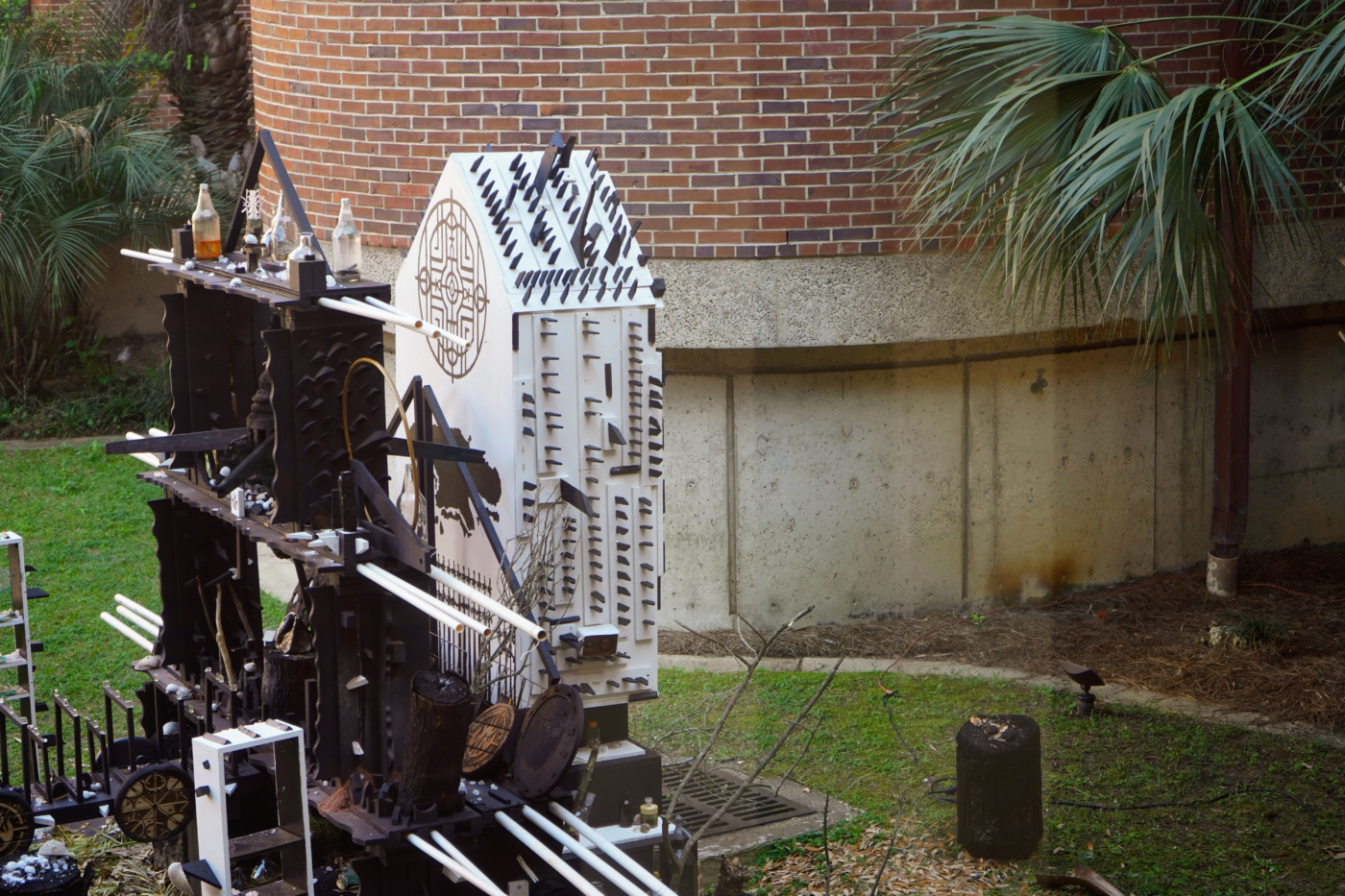

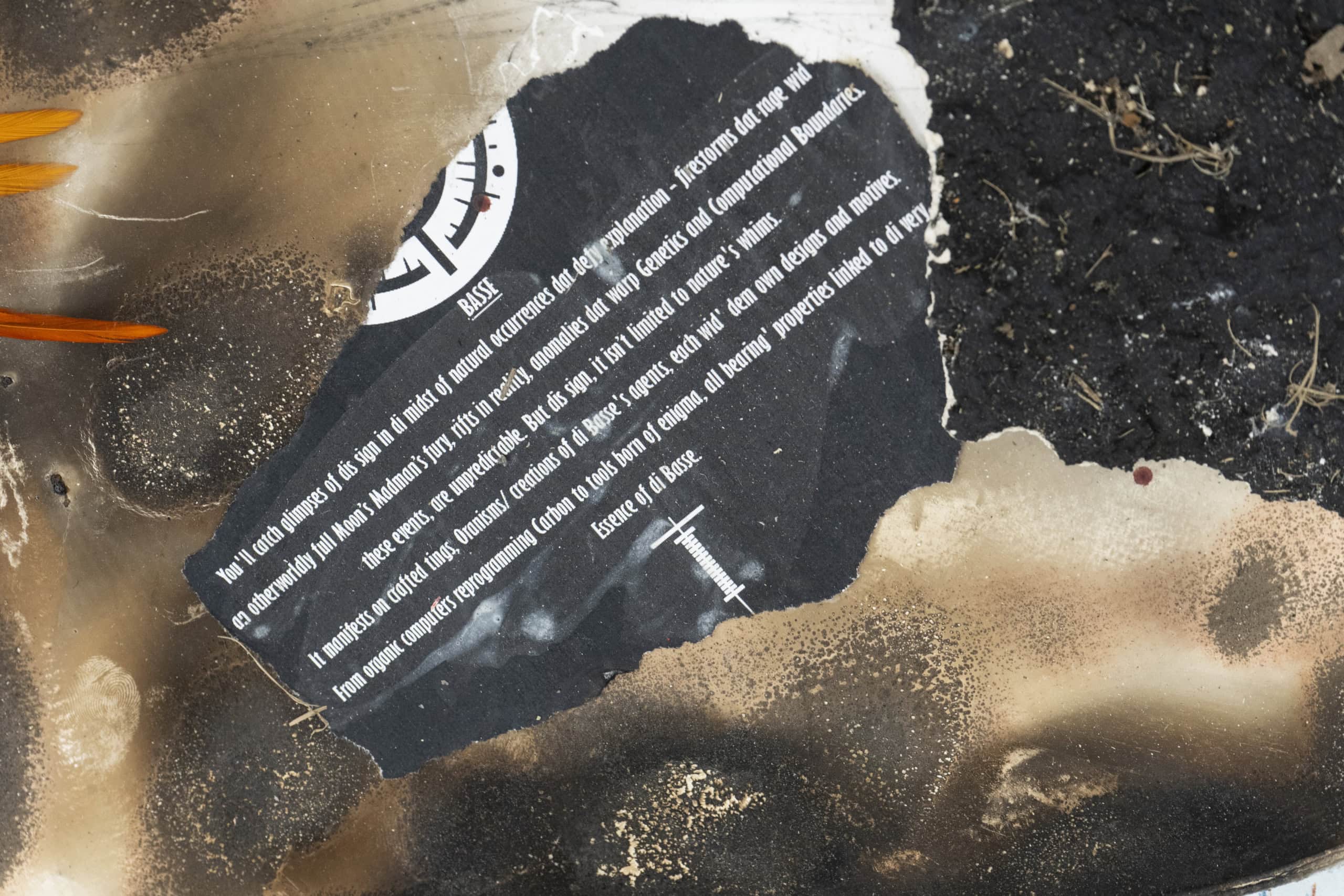
Born in Jamaica and raised in a devout Christian household, Lewis began his practice as a form of spiritual inquiry—an attempt to parse the structures and icons that shaped his early life: the church, the sea, the cross, trees, and bones. Over time, this inquiry expanded into a broader exploration of mythic systems and the human and nonhuman infrastructures that scaffold collective experience. What ripples do I want to be part of? Lewis asks—a question that recurs in his practice as a generative, ever-shifting intention. Among the metaphors that guide his work, fire emerges: a force of transformation, of crystallization, of emotional combustion. In Lewis’s cosmology, fire alters. Glass, forged through heat and flux, becomes a material of alchemy and ambiguity. Like the ghost fruit of the noni tree—a figure in his iconography—glass holds contradiction: transparent yet concealing, fragile yet sharp, solid yet ephemeral.
After completing his undergraduate studies in design, Lewis began contemplating mortality and transmission. What rituals, he asked, would shape his afterlife? What infrastructures would inherit his body, his labor, his data? He turned to the biology of white blood cells—specifically their programmed death and the afterlife of their information. Even in decay, these cells become knowledge. In this way, death becomes, for Lewis, not a closure but a generative gesture—a moment in which the body becomes archive, signal, offering.
“Materials are never neutralized.”
The story of Henrietta Lacks—whose cells were harvested in 1951 without consent and became foundational to modern medical science—serves as a critical reference point in Lewis’s practice. For him, it is a tragedy of exploitation and an entry into the complexities of consent, afterlife, and the unstable boundary between body and data. Lacks becomes a symbol of persistence—how Black life continues to shape, haunt, and propel the future even when rendered invisible. In Digi Soul (Lax) (2024), Lewis encodes this legacy into digital form. The video’s central figure resembles a techno-glyph: symmetrical, branching, pulsing with light. Its schematic body evokes both circuit boards and spirit trees. The composition recalls what the writer Sylvia Wynter might describe as a “mythopoetic diagram”—an alternative cosmology rooted in survival and speculative transformation. Suspended in a monochrome field of glitch and static, the figure appears both cruciform and blooming. Through Digi Soul, Lewis visualizes the Basse not only as infrastructure, but as invocation: a ghost system that binds the organic to the digital, not through extraction but through mutual haunting. Within every flicker and fragment, there is the potential for something more.
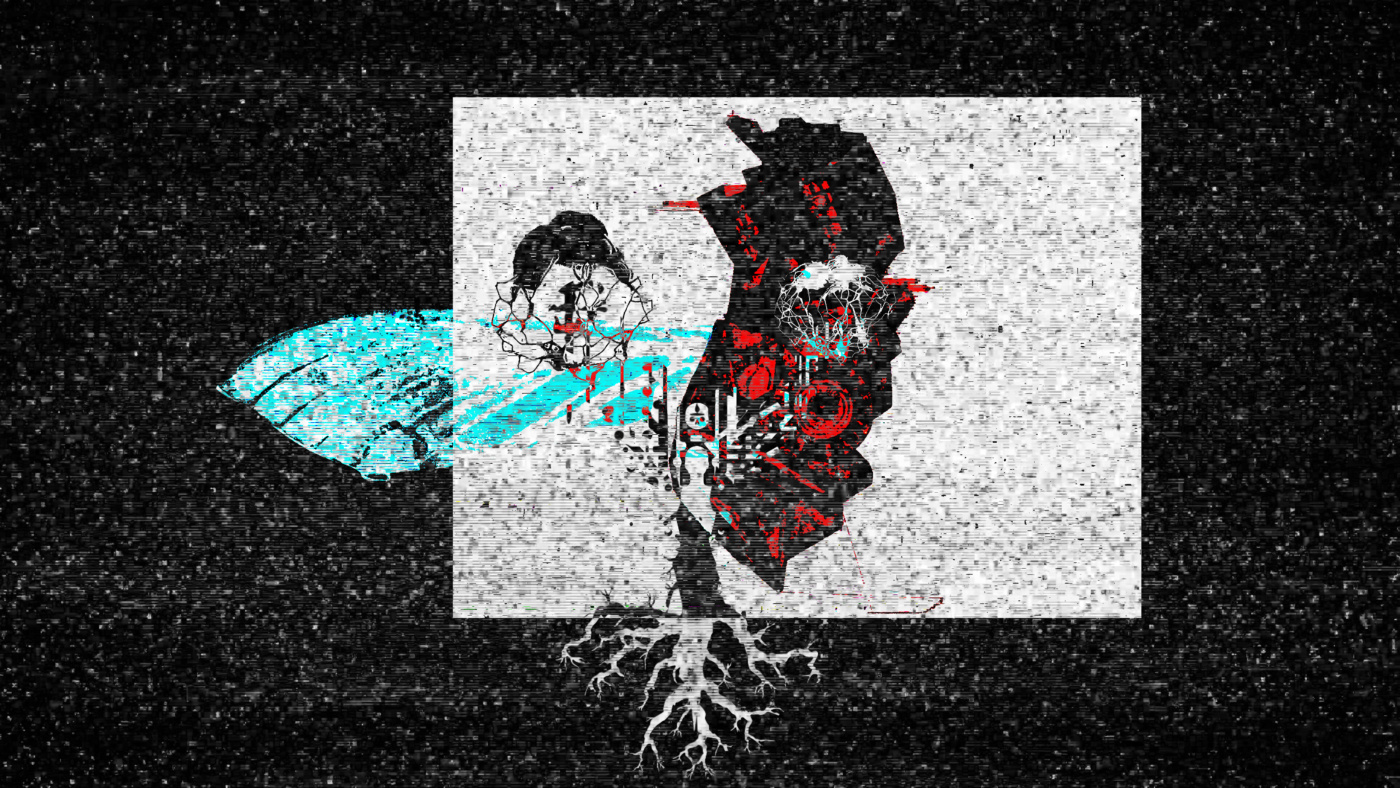
In contrast, while contemplating that which is tangible but unseen to the eye, like the human cell, Lewis often collects materials by sight and on foot—fallen branches, bits of wire, scorched fruit, cast-off plastic, oxidized metal. These fragments, marked by weather and time, form part of a living archive. They are reconfigured into dense, layered environments: altars of accumulation where light fractures across glass shards, rust hums with memory, and organic matter is left to decay in real time. These spaces slow down the viewer, who is instead invited to listen, feel, and navigate. Shifting textures underfoot, sudden flashes of mirrored surface, the faint trace of sound or scent: All guide a multisensory, nonlinear encounter. The installations collapse fixed timelines and foster an attunement—where past and present, grief and speculation, cohabitate. Basse enters not only the physical structure of the work, but the viewer’s own perceptual and temporal rhythms.
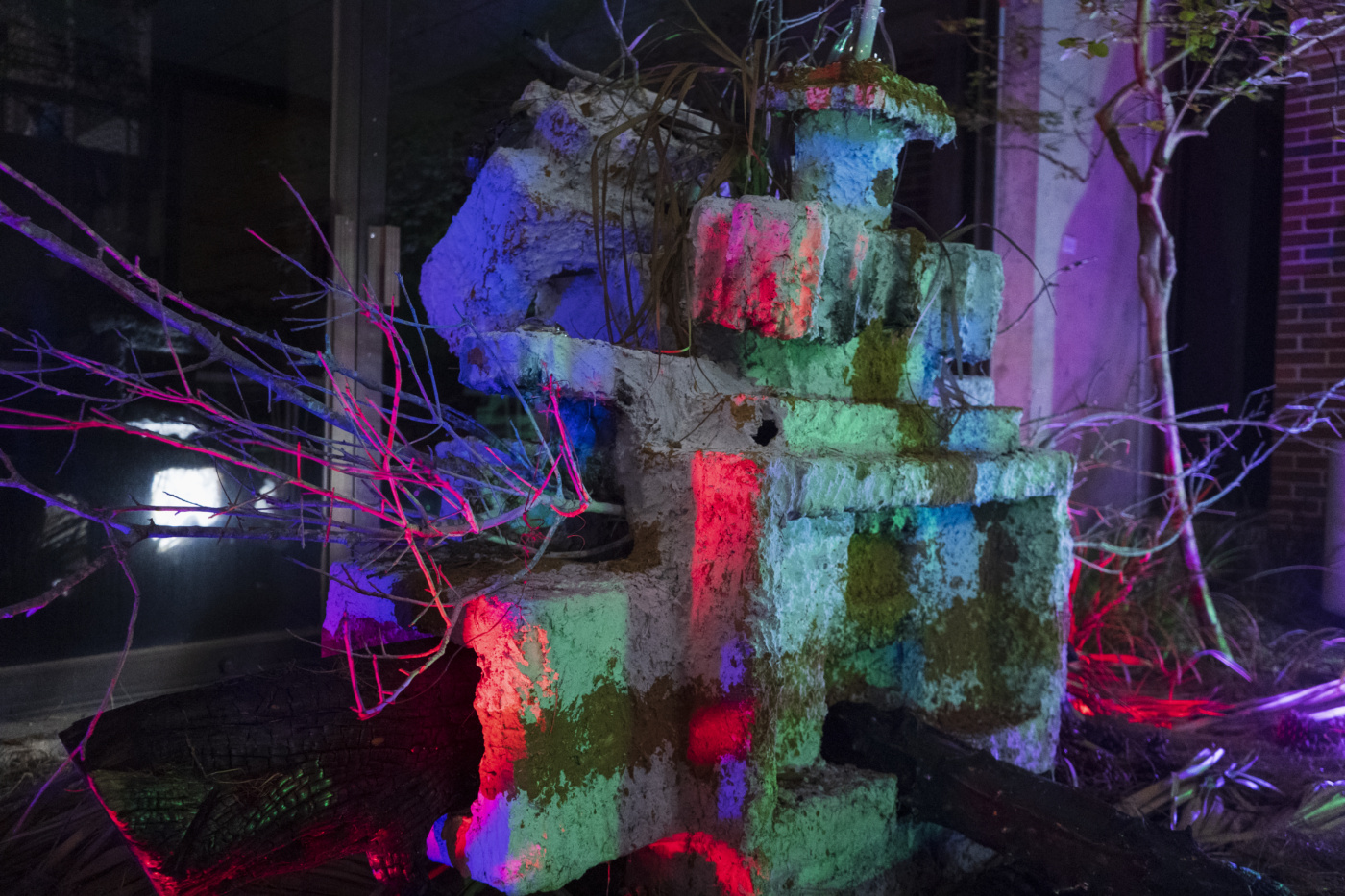
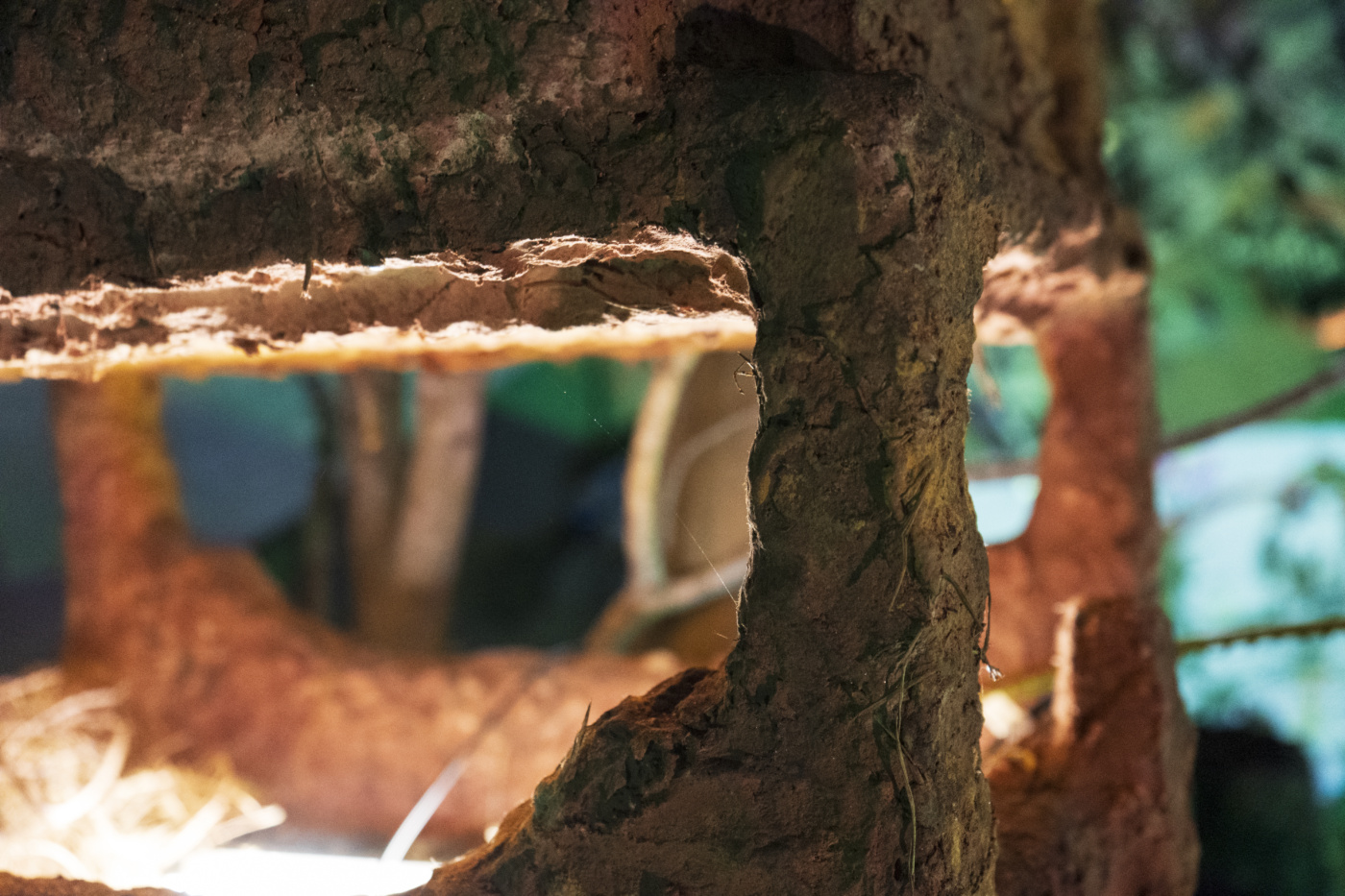

An ethic underlies Lewis’s approach—a refusal to treat any part of the world as inert, dead, or discarded. Jamaica and the Caribbean, often rendered in dominant imaginaries as sites of extraction or absence, are reconfigured here as generative grounds of knowledge, energy, and renewal. Materials are never neutralized. In works like Mystery Antenna Key, Lewis uses burned and rusted metals as conduits for ancestral presence. Lewis’s use of detritus recalls what the theorist Saidiya Hartman terms “the afterlife of property”. The Basse metabolizes loss and neglect into possibility. It is a ghost system—never fully visible, only activated in glimpses: a flicker, a hum, a rupture in the grid. The sculpture’s cruciform structure is wired with antennas that stretch outward like dendrites—extensions that resemble both neural networks and spirit receivers. Through these hybrid forms, Lewis offers a speculative interface for memory and transmission. The work reaches for the past not to preserve it in static form, but to let memory circulate—fragmented, encoded, always in motion. Transmission here is never clean or complete; it crackles with interference, with the haunting of what’s been lost and the urgency of what remains.
This refusal of fixity—this insistence on multiplicity, on form as phenomenon—is a throughline in Lewis’s work. He draws analogies between nuclear semiotics and sacred geometry, Dogon cosmologies and Christian iconography, water’s chaotic flow and the engineered precision of digital code. These aren’t casual references; they signal an urgent poetics of transmission. Like the speculative warnings of nuclear semiotics—designed to speak across millennia without language—his sculptures embed meaning into structure, vibration, and form. They hum, gesture, resonate. Each pairing becomes part of an evolving grammar, one that resists closure and invites interpretation. Lewis’s practice hinges on the encounter between systems—emotional, material, spiritual, architectural, and technological—each folding into the other, each charged with memory and futurity.
Tevin Lewis practices a kind of material alchemy. His sculptures––built from fragments—aren’t just found; they’re transformed through fire, decay, and ritual care. In Lewis’s hands, these fragments, these preconceptions of the discarded, become the raw material of a new technosphere. For Lewis, it is neither nostalgic nor ironic. He honors brokenness. His work asks urgent questions about how Black knowledge systems persist and evolve—how they are encoded in objects, landscapes, and the very materials of daily life.
Lewis offers an art of deep listening—one that turns to the ancestral not as retreat, but as radical future. In an era where the lines between digital and analog, past and future, body and data blur, his practice embraces this porousness as fertile ground. His worlds are not perfect. They are haunted yet restless. They offer one a map, not a path back, but a way forward. A way to move through the hauntings, not with fear, but with attention. Because, for Lewis, it’s about the act of attention. In the tender, deliberate work of seeing, making, and believing, one might begin to recognize the ghost engine that hums beneath it all.
